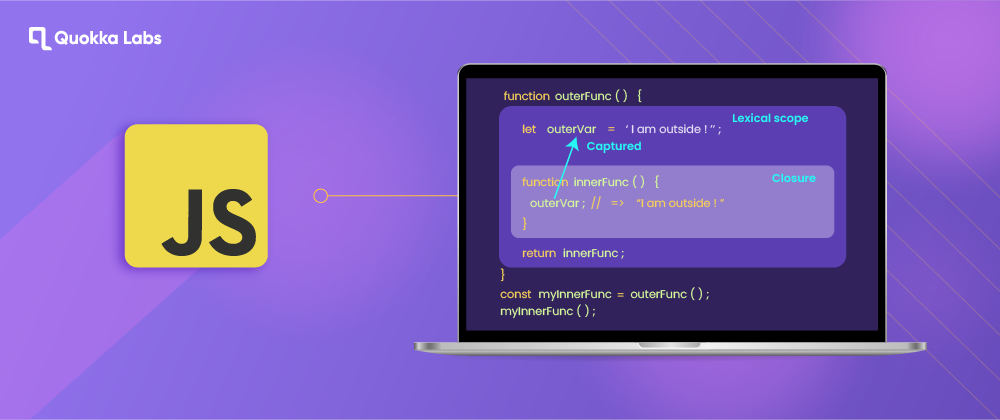Professional JavaScript developers may know the Closure and Scope. Still, the rising JavaScript programmers may need to learn more about it. No worries! If you don't know, this blog post is for you to understand how Closure and scopes work in JS efficiently and can help speed up your app development.
If you are new to mobile app development, you can see our best blog on step-by-step procedures: Read More.
Closure and Scopes are very much needed in JavaScript, but sometimes newcomers need clarification. So, let's start with the Scope first.
What Are Scopes and How Do They Work In JS?
Scope gives you access to variables you need. In JavaScript, there are two types of Scopes, described below:
Global Scope
They are variables declared outside of all functions or out of the ({}).
const hi = 'Hi QL Reader!'
function sayHi () {
console.log(hi)
}
console.log(hi) // 'Hi QL Reader!'
sayHi() // 'Hi QL Reader!
You can declare variables, but it's not recommended to do so because there are chances for naming collisions. There can be same-name variables so that errors may occur.
Local Scope
They are only usable in a specific part of the code, so they are called local Scope. There are two Local Scopes: Function scope and block scope.
Function Scope
Function scope is you can only access a variable within the function. Let's see the example below.
function sayHi () {
const hi = 'Hi QL Reader!'
console.log(hi)
}
sayHi() // 'Hi QL Reader!'
console.log(hi) // Error, hi is not defined
Block Scope
Block Scope means declaring a variable with const or within ({}). It means you can access only the curly braces. Let's see the example below:
{
const Hi = 'Hi QL Reader!'
console.log(Hi) // 'Hi QL Reader!'
}
console.log(hi) // Error, hi is not defined
Scopes And Function Hoist
Functions are always hoisted on the top when they are declared. They are hoisted on the top of the current Scope. See the below example.
// Same as the one below
sayHi()
function sayHi () {
console.log('Hi QL Reader!')
}
// The same as the code above
function sayHi () {
console.log('Hi QL Reader!')
}
sayHi()
Now, if we declare a function with expression, functions will not be lifted on the top of the current Scope. Let's see the example below.
sayHi() // Error, sayHi is not defined
const sayHi = function () {
console.log(aFunction)
}
Nested Scopes
It has a behavior called lexical scoping. It happens when a function is defined in another function. Hence, the inner function gets access to the outer function's var., but the outer function does not access the inner function var.
function outerFunction () {
const outer = `I'm the outer function!`
function innerFunction() {
const inner = `I'm the inner function!`
console.log(outer) // I'm the outer function!
}
console.log(inner) // Error, inner is not defined
}
Debugging Scopes with DevTools
Debugging is easy with Firefox and Chrome DevTools. There are two methods to use these functions.
- The first method is using the keyword "debugger" in the code. It will pause Javascript execution in browsers so JavaScript developers can debug.
function prepareCake (flavor) {
// Adding debugger
debugger
return function () {
setTimeout(_ => console.log(`Made a ${flavor} cake!`), 1000)
}
}
const makeCakeLater = prepareCake('banana')
You can also move the keyword into the Closure:
function prepareCake (flavor) {
return function () {
// Adding debugger
debugger
setTimeout(_ => console.log(`Made a ${flavor} cake!`), 1000)
}
}
const makeCakeLater = prepareCake('banana')
- The second way is adding a breakpoint in your code directly in the sources.
What Are Closures and How Do They Work In JS?
The Closure is a type of boundary. The Closure is when you create a function in another function. The inner function is called Closure. At last, the Closure is returned so you can use the outer function's var.
function outerFunction () {
const outer = `Outer variable!`
function innerFunction() {
console.log(outer)
}
return innerFunction
}
outerFunction()() // Outer variable!
We can compress the code also like below:
function outerFunction () {
const outer = `Outer variable!`
return function innerFunction() {
console.log(outer)
}
}
outerFunction()() // Outer variable!
Using Closure to Limiting Errors
Many errors, like Ajax Requests, a timeout, or a console.log statement, can happen. But be careful using closures because Closure may cause ajax request errors too. To understand it better, let's go to the example.
function makeCake() {
setTimeout(_ => console.log(`Made a cake`), 1000)
}
You can see that it got a timeout. Let's see another example.
function makeCake(flavor) {
setTimeout(_ => console.log(`Made a ${flavor} cake!`), 1000)
}
Now you can see that the cake is immediately made after knowing the flavor. But we want to make the cake when the time is right. Let's see the code below.
function prepareCake (flavor) {
return function () {
setTimeout(_ => console.log(`Made a ${flavor} cake!`), 1000)
}
}
const makeCakeLater = prepareCake('banana')
// And later in your code...
makeCakeLater()
// Made a banana cake!
As you can see how we used closures to make fewer errors.
Closures with Private Variables
As previously said that in a function, a variable could not access outside the function. So these are called private variables. Sometimes java developers need private variables. So here's how you can get the help of closures.
function secret (secretCode) {
return {
saySecretCode () {
console.log(secretCode)
}
}
}
const theSecret = secret('QL is amazing')
theSecret.saySecretCode()
// 'QL is amazing'
Wrapping Up!
Scopes and Closures are relatively easy to learn as a beginner JavaScript developer. They are effortless to know. Well, this was about Closures and Scopes. Still, even pro JavaScript developers sometimes need help solving complex project errors.
So, in that case, our top 3% of experts can help you get out of that situation; hire JavaScript developers to solve the mistakes quickly. Also, get apps developed speedily with our mobile app development services.








Oldest comments (0)